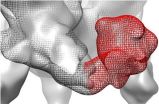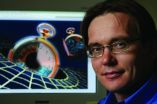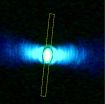(Press-News.org) Here's another reason to pay close attention to microbes: Current climate models probably overestimate the amount of carbon that will be released from soil into the atmosphere as global temperatures rise, according to research from the US Department of Energy's Lawrence Berkeley National Laboratory (Berkeley Lab).
The findings are from a new computer model that explores the feedbacks between soil carbon and climate change. It's the first such model to include several physiologically realistic representations of how soil microbes break down organic matter, a process that annually unleashes about ten times as much carbon into the atmosphere as fossil fuel emissions. In contrast, today's models include a simplistic representation of microbial behavior.
The research is published Nov. 17 on the website of the journal Nature Climate Change.
Based on their results, the Berkeley Lab scientists recommend that future Earth system models include a more nuanced and dynamic depiction of how soil microbes go about the business of degrading organic matter and freeing up carbon.
This approach could help scientists more accurately predict what will happen to soil carbon as Earth's climate changes. These predictions are especially important in vulnerable regions like the Arctic, which is expected to warm considerably this century, and which holds a vast amount of carbon in the tundra.
"We know that microbes are the agents of change when it comes to decomposing organic matter. But the question is: How important is it to explicitly quantify complex microbial interactions in climate models?" says Jinyun Tang, a scientist in Berkeley Lab's Earth Sciences Division who conducted the research with fellow Berkeley Lab scientist William Riley.
"We found that it makes a big difference," Tang says. "We showed that warming temperatures would return less soil carbon to the atmosphere than current models predict."
Terrestrial ecosystems, such as the Arctic tundra and Amazon rainforest, contain a huge amount of carbon in organic matter such as decaying plant material. Thanks to soil microbes that break down organic matter, these ecosystems also contribute a huge amount of carbon to the atmosphere.
Because soil is such a major player in the carbon cycle, even a small change in the amount of carbon it releases can have a big affect on atmospheric carbon concentrations. This dynamic implies that climate models should represent soil-carbon processes as accurately as possible.
But here's the problem: Numerous empirical experiments have shown that the ways in which soil microbes decompose organic matter, and respond to changes in temperature, vary over time and from place to place. This variability is not captured in today's ecosystem models, however. Microbes are depicted statically. They respond instantaneously when they're perturbed, and then revert back as if nothing happened.
To better portray the variability of the microbial world, Tang and Riley developed a numerical model that quantifies the costs incurred by microbes to respire, grow, and consume energy.
Their model accounts for internal physiology, such as the production of enzymes that help microbes break down organic matter. It includes external processes, such as the competition for these enzymes once they're outside the microbe. Some enzymes adsorb onto mineral surfaces, which means they are not available to chew through organic matter. The model also includes competition between different microbial populations.
Together, these interactions-from enzymes to minerals to populations-represent microbial networks as ever-changing systems, much like what's observed in experiments.
The result? When the model was subjected to a 4 degrees Celsius change, it predicted more variable but weaker soil-carbon and climate feedbacks than current approaches.
"There's less carbon flux to the atmosphere in response to warming," says Riley. "Our representation is more complex, which has benefits in that it's likely more accurate. But it also has costs, in that the parameters used in the model need to be further studied and quantified."
Tang and Riley recommend more research be conducted on these microbial and mineral interactions. They also recommend that these features ultimately be included in next-generation Earth system models, such as the Department of Energy's Accelerated Climate Modeling for Energy, or ACME.
INFORMATION:
The research was supported by the Department of Energy's Office of Science.
Lawrence Berkeley National Laboratory addresses the world's most urgent scientific challenges by advancing sustainable energy, protecting human health, creating new materials, and revealing the origin and fate of the universe. Founded in 1931, Berkeley Lab's scientific expertise has been recognized with 13 Nobel prizes. The University of California manages Berkeley Lab for the U.S. Department of Energy's Office of Science. For more, visit http://www.lbl.gov.
Fruit flies do not always conform to the norm. When female fruit flies have to decide where to lay their eggs, they take their lead from what they see most others in their group do. However, some do take their personal preferences into account. So says Marine Battesti of the Université Paris-Sud in France, lead author of a study in Springer's journal Behavioral Ecology and Sociobiology.
The site on which an insect chooses to lay her eggs is very important for the development and survival of future generations. Such choices are not fixed, but are influenced by the ...
UC Davis researchers are getting a new look at the workings of HIV and other viruses thanks to new techniques in electron microscopy developed on campus.
The envelope (or Env) protein of HIV is a key target for vaccine makers: it is a key component in RV144, an experimental vaccine that is so far the only candidate to show promise in clinical trials. Also called gp120, the Env protein associates with another protein called gp41 and three gp120/gp41 units associate to form the final trimeric structure. The gp120 trimer is the machine that allows HIV to enter and attack ...
WASHINGTON, Nov. 17, 2014 -- They are seemingly the most popular thing on the Internet, the subject of millions of videos and hundreds of memes: cats. This week Reactions answers some of the biggest kitty questions out there: Why does catnip make most cats go crazy? What does it mean when your cat rubs against your leg? How does kitty litter clump? Check out the nearly purr-fect video here: http://youtu.be/6_C9i-2QGeU.
Subscribe to the series at Reactions YouTube, and follow us on Twitter @ACSreactions to be the first to see our latest videos.
INFORMATION:
The American ...
ABBOTT PARK, Ill., Nov. 17, 2014 - People aged 65 and older, who were being treated for chronic obstructive pulmonary disease (COPD) in the hospital and received nutrition treatment (oral nutrition supplements) had reduced lengths of stay, hospital costs and chances of returning to the hospital within 30-days, according to a study published in CHEST.
Chronic obstructive pulmonary disease (COPD) -- which includes conditions like chronic bronchitis and emphysema -- is a lung disease that compromises breathing. As COPD often occurs among seniors, it is one of the leading ...
Alexandria, Va. -- Hurricane Sandy struck the U.S. East Coast in October 2012, leaving about $65 billion of damage in its wake and raising the question of how to mitigate the damage from future storms. It's a question that arises in the wake of most natural disasters: What steps can society take to protect itself from storms, floods, landslides, earthquakes, tsunamis or volcanic eruptions? But the question itself illustrates the complexity of preparing for natural disasters.
Our first instincts might be to protect ourselves as well as possible, but reality sets in quickly: ...
CORVALLIS, Ore. - Engineers at Oregon State University have identified a method to rapidly prepare frozen red blood cells for transfusions, which may offer an important new way to manage the world's blood supply.
It's already possible to cryopreserve human red blood cells in the presence of 40 percent glycerol, but is rarely done because of the time-consuming process to thaw and remove the glycerol from the blood. This can take an hour or more and makes it logistically difficult to use frozen blood.
However, some initial experiments and computer modeling of a proposed ...
RENO, Nev. - The everyday use of a GPS device might be to find your way around town or even navigate a hiking trail, but for two physicists, the Global Positioning System might be a tool in directly detecting and measuring dark matter, so far an elusive but ubiquitous form of matter responsible for the formation of galaxies.
Andrei Derevianko, of the University of Nevada, Reno, and his colleague Maxim Pospelov, of the University of Victoria and the Perimeter Institute for Theoretical Physics in Canada, have proposed a method for a dark-matter search with GPS satellites ...
LIVERMORE, Calif. - Lawrence Livermore National Laboratory researchers have developed an efficient method to measure residual stress in metal parts produced by powder-bed fusion additive manufacturing.
This 3D printing process produces metal parts layer by layer using a high-energy laser beam to fuse metal powder particles. When each layer is complete, the build platform moves downward by the thickness of one layer, and a new powder layer is spread on the previous layer.
While this process is able to produce quality parts and components, residual stress is a major ...
The race to make computer components smaller and faster and use less power is pushing the limits of the properties of electrons in a material. Photonic systems could eventually replace electronic ones, but the fundamentals of computation, mixing two inputs into a single output, currently require too much space and power when done with light.
Researchers at the University of Pennsylvania have engineered a nanowire system that could pave the way for this ability, combining two light waves to produce a third with a different frequency and using an optical cavity to amplify ...
Rice University scientists have invented a novel cathode that may make cheap, flexible dye-sensitized solar cells practical.
The Rice lab of materials scientist Jun Lou created the new cathode, one of the two electrodes in batteries, from nanotubes that are seamlessly bonded to graphene and replaces the expensive and brittle platinum-based materials often used in earlier versions.
The discovery was reported online in the Royal Society of Chemistry's Journal of Materials Chemistry A.
Dye-sensitized solar cells have been in development since 1988 and have been the subject ...




